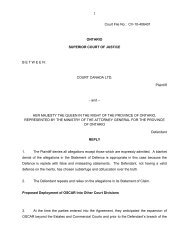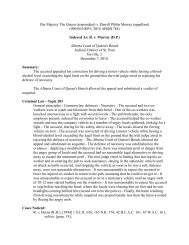Create successful ePaper yourself
Turn your PDF publications into a flip-book with our unique Google optimized e-Paper software.
SUPREME COURT OF THE STATE OF NEW YORK -- NEW YORK COUNTY<br />
PRESENT: HON. PAQL WQOTEN Justlce `<br />
DOUGLAS D. MENAGH, as Executor of the Estate of CLAIRE MENAGH, deceased, Plaintiff,<br />
-against-<br />
DANA BREITMAN, JULIETTE BREITMAN, RACHEL KOHN and JACOB KOHN, Defendants.<br />
The following papers were read on this Motion by defendant Juliette Breitman to dismiss pursuant to<br />
Section 3211 of the Clvll Practice Law and Rules.<br />
...<br />
ln this action for personal injury, plaintiff alleges that the infant defendants, who were racing bicycles on a<br />
sidewalk while under the supervision of their parent defendants, struck the plaintiff with their bicycles,<br />
causing severe injuries to the elderly plaintiff Claire Menagh. The infant defendant Juliet Breitman, sued<br />
herein as Juliette Breitman, seeks in this pre-answer motion to dismiss plaintiff's complaint, as against her<br />
only, based upon documentary evidence and upon failure to state a cause of action, pursuant to CPLR §<br />
32l1(a)(1) & (7). Defendant-movant has attached her birth certificate as an exhibit to her motion papers.<br />
The sole issue before the Court is whether an infant aged four years, nine months, is non sui juris,<br />
incapable of negligence as a matter of law, under the facts presented.<br />
Page 1 of 6<br />
------------------<br />
CPLR 3211(a) provides:<br />
(a) Motion to dismiss cause of action. A party may move for judgment dismissing one or more causes<br />
ofaction asserted against him on the ground that:<br />
1. A defense is founded on documentary evidence; ...<br />
7. the pleading fails to state a cause of action[.]<br />
Pursuant to CPLR 3211(a)(1), in order to "prevail on a motion to dismiss based on documentary evidence,<br />
the documents relied upon must definitively dispose of plaintiffs claim (Bronxville Knolls v Webster Town<br />
Ctr. Pshp., 221 AD2d 248 (1st Dept. 1995); Juliano v McEntee, 150 AD2d 524 [2d Dept 1989]; Demes v<br />
325 W End Ave. Corp., 127 AD2d 476 [1st Dept 1986]). A CPLR 321 1(a)(1) "motion may be appropriately<br />
granted only where the documentary evidence utterly refutes plaintiffs factual allegations, conclusively<br />
establishing a defense as a matter of law" (Goshen v Mut. Life Ins. Co., 98 NY2d 314, 326-27 [2002]).<br />
Upon a 3211(e)(7) motion to dismiss for failure to state a cause of action, the question for us is whether the<br />
requisite allegations of any valid cause of action cognizable by the state courts 'can be fairly gathered<br />
from all the averments‚ (Foley v D'agostino, 21 AD2d 60, 65 [1st Dept. 1964], quoting Condon v<br />
Associated Hosp. Serv., 287 NY 411, 414 [1942]). ln order to defeat a pre-answer motion to dismiss<br />
pursuant to CPLR 3211, the opposing party need only assert facts of an evidentiary nature which fit within<br />
any cognizable legal theory. (Bonnie & Co.<br />
Fashions, Inc. v. Bankers Trust Co., 262 A.D.2d 188 [1st Dept.1999].)<br />
When determining a CPLR 3211(a) motion, "we liberally construe the complaint and accept as true the<br />
facts alleged in the complaint and any submissions in opposition to the dismissal motion" (511 W 232nd<br />
Owners Corp. v. Jennifer Realty Co., 98 NY2d 144, 151-152 [2002]; Leon v Martinez, 84 NY2d 83, 87,<br />
[1994]; Sokoloff v Harriman Estates Dev. Corp., 96 NY2d 409, [2001]; Wieder v Skala, 80 NY2d 628,<br />
[1992]). "We also accord plaintiffs the benefit of every possible favorable inference" (511 W 232nd Owners<br />
Corp., 98 NY2d at 152; Sokoloff<br />
Page 2 of 6<br />
--------------------------------
v Harriman Estates Dev. Corp, 96 NY2d at 414).<br />
Non Sui Juris<br />
Defendant-movant correctly notes that infants under the age of four are conclusively presumed incapable<br />
of negligence (Verni v Johnson, 295 NY 436, 438 [1946] ). Defendant-movant Juliet Breitman, however,<br />
was over the age of four at the time of the subject incident.<br />
For infants above the age of four, there is no bright line rule, and "in considering the conduct of an infant in<br />
relation to other persons or their property, the infant should be held to a standard of care . . . by what is<br />
expected of a reasonably prudent child of that age, experience, intelligence and degree of development<br />
and capacity" (Gonzalez v Medina, 69 AD2d 14, 18 [1st Dept. 19791, citing Camardo v. New York State<br />
Rys. 247 N.Y. 111 [1928]; see also Steeves v City of Rochester, 293 NY 727, 731 [1944] ["The general<br />
rule is that a child is not guilty of contributory negligence if it has exercised the care which may reasonably<br />
be expected of a child of similar age and capacity."']; Weidenfeld v Surface Transp. Corp. of N. Y., 269 AD<br />
341, 345 [1st Dept 1945]; McLoughin v Bonpark Realty Corp., 260 AD 471 [1st Dept. 1940]; Redmond v<br />
City of New York, 81 AD2d 908, 909 [2d Dept. 19811, affd 55 NY2d 796 [1981]; Eagle v Janof, 12 AD2d<br />
638, 639 [2d Dept. 1960]; Yun Jeong Koo v St. Bernard, 89 Misc 2d 775, 779 [Sup Ct. Queens County<br />
1977]).<br />
If conflicting inferences may be drawn, the question is one of fact; if only one inference can be drawn the<br />
question is one of law" (Camardo, 247 NY at 116 [1928]; accord Steeves, 239 NY at 731-32; see also<br />
Weidenfeld, 269 AD at 345; Republic Ins. Co. v Michel, 885 F Supp 426, 432-34 [EDNY 1995] [applying<br />
New York State Law, an infant aged four years, four months was not automatically non sui juris, but could<br />
be found non sui juris upon the presentation of "substantial evidence regarding the child’s lack of<br />
intelligence and maturity”]; cf.<br />
Boyd v Trent, 297 AD2d 301 [2d Dept. 2002] [held, without preliminary discussion, that four year old infant<br />
was non sui juris for contributing to accident by distracting parent from driving,<br />
Page 3 of 6<br />
---------------------------------<br />
presumably because Second Department did not believe the four year old could appreciate the danger of<br />
distracting its parent]).<br />
This method of analysis has resulted in ostensibly conflicting case law, in which children less than a<br />
month apart in age are treated differently as to sui juris status. For example, a child aged four years, ten<br />
months who is hit by a car while crossing the street at his mother's direction is non sui juris as a matter of<br />
law (Ehrlich v Marra, 32 A.D.2d 638 [2d Dept. 1969]).<br />
On the other hand, an unsupervised child of the same age who is struck by a car will not be held non sui<br />
juris as a matter of law, absent evidence that the child is otherwise unable to comprehend the danger<br />
posed by an approaching vehicle (e.g. Camardo, 247 NY at 111, Yun Jeong Koo, 89 Misc 2d at 775).<br />
According to defendant-movant, supervision is the distinguishing factor between these cases. The Court<br />
disagrees. A parent's presence alone does not give a reasonable child carte blanche to engage in risky<br />
behavior such as running across a street. A reasonably prudent child, whom we may presume has been<br />
told repeatedly by the age of four to look both ways before crossing a street(1), knows that running across<br />
a street is dangerous even if there is a parent nearby. Despite this, if a parent or other trusted adult actively<br />
directs a four year old child to cross a street at a certain time, the only logical inference is that the child will<br />
reasonably believe it is safe to cross the street at that time. Because a child above the age of four will only<br />
be non sui jurls if it is impossible under the circumstances to draw any other inference, parental<br />
supervision is unlikely to affect the sui juris status of a child above the age of four unless the parent has<br />
taken an active role in encouraging the child’s conduct (see Camardo, 247 NY at
_______________<br />
fn1 See Yun Jeong Koo, 89 Misc 2d at 779 (noting that the Camardo decision would be more rational now<br />
that, "in this modern day of enlightenment, children are prone to view television programs which, by voice<br />
and sight exemplification, point out to youngsters of very early age the necessity of their looking and<br />
listening to avoid danger or dangerous conditions.").<br />
Page4 of 6<br />
-----------------------------<br />
111).<br />
Defendant-movant's reliance on Romanchuk v County of Westchester (40 A.D.2d 877 [2d Dept. 1972]), to<br />
establish that a child days shy of the age of five can be held non sui juris as a matter of law, is therefore<br />
misplaced. ln that case, the child was actively placed onto a sled and pushed down a slope by his father,<br />
whereupon the sled was allegedly struck by a vehicle.<br />
The Romanchuk child was declared not to be contributorily negligent as a matter of law, not because of<br />
his age or because of a mere parental presence, but because the only logical inference was that the child<br />
reasonably believed that allowing his father to push him on a sled was a safe course of action.<br />
Applying the Camardo conflicting inferences rule and reasonable child standard to the facts presented<br />
here, defendant-movant cannot be held non sui juris as a matter of law. The motion papers and pleadings<br />
do not indicate that defendant-movant's mother had any active role in the alleged incident, only that the<br />
mother was "supervising," a term that is too vague to hold meaning here. There are no exhibits containing<br />
evidence as to the defendant-movant's lack of intelligence or maturity, nor are there any other mitigating<br />
factors apparent in the record that would indicate that another child of similar age and capacity under the<br />
circumstances could not have reasonably appreciated the danger of riding a bicycle into an elderly<br />
woman.<br />
Furthermore, even if defendant-movant had alleged facts which, if true, might constrain the Court to a<br />
single inference, all facts must be viewed in a light most favorable to plaintiff (see supra; 511 W. 232nd<br />
Owners Corp., 98 NY2d at 152; Sokoloff v Harriman Estates Dev. Corp, 96 NY2d at 414). Merely<br />
introducing such allegations would therefore still be insufficient.<br />
Rather, defendant-movant had the burden of conclusively establishing such allegations.<br />
Because defendant-movant has utterly failed to allege, let alone establish, facts constraining the Court to<br />
a single inference, defendant-movant's sui juris status is a matter of fact for a jury, and this motion to<br />
dismiss must be denied.<br />
Page 5 of 6<br />
--------------------------------<br />
ORDERED, that the motion to dismiss by defendant Juliet Breitman is denied; and it is further, ORDERED<br />
that counsel are directed to appear for a preliminary conference in Room It 320, 80 Centre Street, on<br />
December 8, 2010, at 11:00 A.M.; and it is further ORDERED that the plaintiff shall serve a copy of this<br />
order with notice of entry upon all parties.<br />
This constitutes the Decision and Order of the Court.<br />
Dated: October 1 ,2010<br />
PAUL WOOTEN J.S.C.<br />
Page 6 of 6



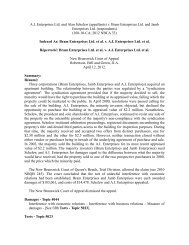
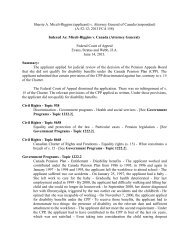

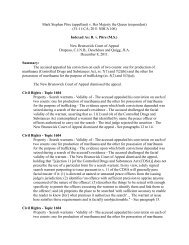
![Jones (appellant) v. Kaney (respondent) ([2011] UKSC 13 ... - Slaw](https://img.yumpu.com/46577625/1/190x245/jones-appellant-v-kaney-respondent-2011-uksc-13-slaw.jpg?quality=85)
